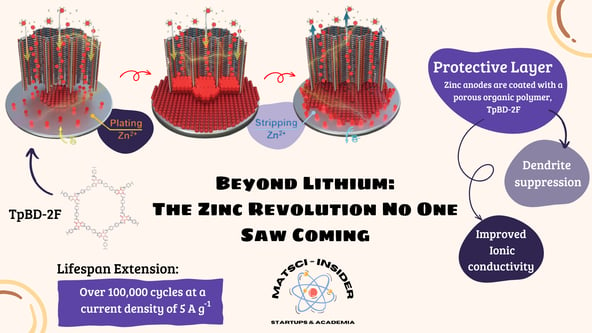
Beyond Lithium: The Zinc Revolution No One Saw Coming
Can Zinc Based batteries take down Lithium? A recent paper overcame one of the main hindrance of ZInc Batteries by using a cheap polymer coating. Will this make it onto the market? Let's dive in!
RESEARCHBATTERY
Samuel Iteanu
1/30/20253 min read
What if the future of batteries didn’t rely on lithium at all?
Researchers have long searched for an alternative, and one contender might now stand out: zinc-based batteries. Safer, cheaper, and more sustainable, zinc has all the right ingredients, one might ask why it was not used before! Except that Zinc batteries have one critical flaw: a short lifespan due to dendrite formation ("needles" growing from the anode and able to short circuit the battery if they reach the cathode, tldr: not a great situation).
Nevertheless, a recent article from the Technical University of Munich (TUM) may have finally cracked the code! Their latest breakthrough introduces a porous polymer layer that dramatically improves the longevity of zinc batteries, extending their lifespan to an unprecedented 100,000 charge cycles. This advancement could push zinc into the mainstream as a serious alternative to lithium-ion technology.
Could this be the moment zinc batteries finally step into the spotlight?
The Problem: Why Zinc Batteries Struggle
Zinc batteries have long been considered an ideal alternative to lithium-ion technology (1). Zinc is abundant, affordable, non-toxic, and compatible with water-based electrolytes, making these batteries inherently safer than their lithium counterparts (2). However, they’ve faced a fundamental issue: dendrite growth that lead to rapid degradation.
Dendrites are microscopic zinc structures that form on the anode as the battery charges and discharges. If they grow too long, they can reach the cathode, causing a short circuit and rendering the battery useless. This instability has severely limited the lifespan of zinc batteries, preventing their large-scale adoption.
The Breakthrough: A Polymer Shield Against Degradation
Scientists at TUM have developed a simple yet powerful solution: a nano-engineered polymer layer called TpBD-2F.
This polymer forms a thin, highly ordered protective film on the zinc anode, allowing zinc ions to flow freely while preventing unwanted chemical reactions that lead to dendrite formation. Essentially, it acts as a molecular filter, enabling efficient charge transfer while blocking the destructive growths that shorten battery life.
The results are impressive. With this new protective layer, the researchers have extended the lifespan of zinc batteries to 100,000 charge cycles, a game-changing improvement that could make zinc batteries a viable alternative to lithium-ion in large-scale energy storage.
Why This Matters: Could Zinc Finally Challenge Lithium?
With this breakthrough, zinc batteries could finally move beyond niche applications and into mainstream energy storage. Some of the biggest advantages include:
✅ Safety: Unlike lithium-ion, zinc batteries use non-flammable, water-based electrolytes.
✅ Lower Cost: Zinc is far more abundant and cheaper to source than lithium.
✅ Sustainability: Producing zinc batteries has a smaller environmental footprint.
✅ Longevity: With the new polymer layer, their lifespan could rival lithium-ion.
These advantages make zinc batteries an ideal candidate for grid storage and renewable energy integration. Large-scale solar and wind farms require long-lasting, safe, and cost-effective batteries to store excess energy. If commercialized successfully, zinc batteries could become the backbone of renewable energy storage.
The Challenges Ahead
Despite this breakthrough, zinc batteries still face hurdles before they can replace lithium-ion in all applications:
⚡ Energy Density: Zinc batteries still store less energy per kilogram compared to lithium-ion, making them less practical for weight-sensitive applications like EVs.
⚡ Scaling Production: While the polymer layer solves a major problem, manufacturers need to scale up production efficiently to make zinc batteries competitive.
⚡ Competing Technologies: Other alternatives, such as sodium-ion and solid-state batteries, are also making progress.
While zinc may not yet be ready for electric vehicles or portable electronics, its potential for grid storage and large-scale energy applications is undeniable.
A Step Closer to the Future
The TUM breakthrough proves that zinc batteries can last longer than ever before, bringing them one step closer to mass adoption. With a lifespan of 100,000 cycles, enhanced safety, and lower costs, zinc could become a major player in the battery industry, particularly for renewable energy storage.
Could this innovation finally push zinc batteries into the spotlight? The revolution may be closer than we think.


MatscInsider Ltd © 2025
MatscInder brings Materials Science innovation out of the lab straight to your email!
Terms & Conditions
Want a monthly update?
Subscribe to our newsletter and get a sample of the hot topics in Materials Science every month!
